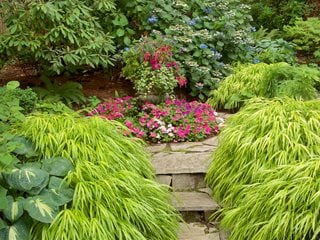Shade Garden Ideas & Design
Lighten up a shady garden with a well-thought-out design and carefully selected plants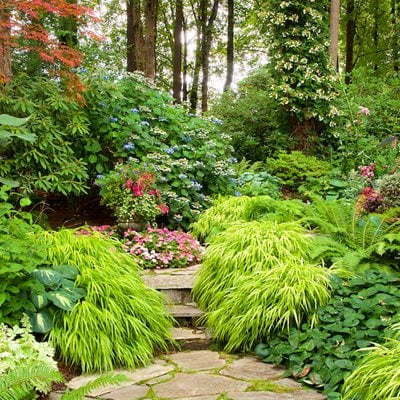
Designer: Vina Winters. Photo: Janet Loughrey.
Both foliage and flower lovers will be impressed by the wide variety of shade-loving plants available that will flourish in filtered light, deep shade, or even a wetland environment.
Check out the resources below to start the journey of transforming your landscape’s shady spots into a stunning low-light garden.
On this page:- POPULAR SHADE GARDEN ARTICLES
- TYPES OF SHADE
- PLANNING A SHADE GARDEN
- HOW TO PLANT A SHADE GARDEN
- SHADE GARDEN CARE TIPS
- SHADE GARDEN DESIGN TIPS
- SHADE GARDEN INSPIRATION
- MORE SHADE GARDENS
POPULAR SHADE GARDEN ARTICLES
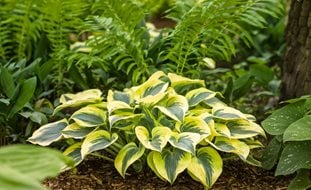
Foliage plants, flowering plants, and even trees perennials, annuals, flowering shrubs, and trees for shade gardens.
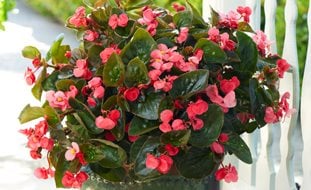
Liven up dark corners of your garden with these tips and plant combinations that thrive in low light.
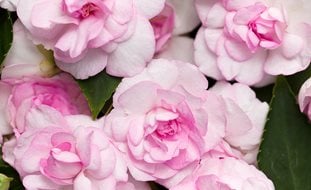
The best annuals to use in shade gardens or containers in shady spots.

Lighten up shady areas of your yard with these reliable perennials.
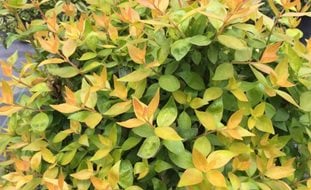
Beautify your yard with these reliable shade-tolerant shrubs and get tips on how to use them in your landscape.

8 tips from Susan Martin, of Gardener Sue’s News, who creates stunning combinations in her shady Michigan garden.
Garden writer Janet Loughrey says, "While shady areas in the landscape can present a host of problems, including slow drainage, poor air circulation and low light, which can result in a failure of plants to thrive, they can also present opportunities if properly designed, prepared, and planted with shade-tolerant varieties." She offers the following shade garden information, design ideas, tips, and inspiration:
TYPES OF SHADE
Not all shade is alike. While some plants can survive and thrive in full shade, others need some direct sunlight. The amount of light your yard receives will help determine your choice of plants. Here are three types of shade:
Partial shade (2 to 6 hours of shade/day) is created by manmade structures including buildings or walls, or natural features such as hillsides that completely block out the sun during part of the day. East-facing areas that receive cooler morning sun are more hospitable to shade plants. West-facing sites are exposed to hot afternoon sun, which can cause foliage burn or other stress.
Full shade (6+ hours of shade/day) refers to an area that receives little or no direct sun. This can occur along the northern side of a home, in a courtyard, between tall urban buildings, or in an area covered by a solid barrier such as a roof overhang or shade cloth.
Dappled shade is most often found underneath a tree canopy, which creates a pattern of sun and shade that moves around throughout the day. The type of tree and size of the canopy will determine the amount of shade.
PLANNING A SHADE GARDEN
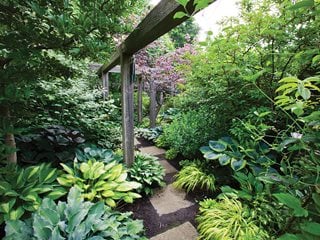
Photo by: Marjorie Harris. See more of this garden.
Evaluate your site. Observe your yard at different times of the year:
- There is less light in spring and fall due to the lower angle of the sun compared to the longer days of summer.
- Areas shaded by deciduous trees will receive more light after the leaves have dropped in late fall, until early spring.
- A shady spot is more prone to standing water since evaporation is slower, so look for areas where water may pool or drain more slowly.
- Microclimates can occur within the same site, affecting air temperature, light, air circulation, and soil.
Research. Look for shade garden design ideas on the internet and by visiting local gardens for inspiration. Make a list of plants and other features such as a pathway, patio, seating area, pergola, statuary, containers, or water feature that will complement plantings.
Draw up a design. Make a plan and draw a rough sketch. For bigger projects, consult with a landscape design professional.
Consider scale. Use plants that are in scale with your shady space. Larger hostas reaching 4 to 6 feet wide may be too big for a small courtyard or narrow side yard. Dwarf varieties are suited to small spaces, while smaller plants can get lost in a large-scale landscape.
Choose a style. Decide on a style that suits your personal taste and complements your home’s facade. Formal Japanese or Asian style will complement a contemporary style house, while an informal woodland garden will enhance a cottage style home.
HOW TO PLANT A SHADE GARDEN
Soil. Make sure soil has proper drainage and nutrients to support plants. Woodland or shade plants generally prefer well-draining, slightly acidic soil amended with compost or other rich organic matter.
Pick the right plants. Choose shade-loving plants that will thrive in your site.
- Avoid siting sensitive plants such as hostas in a spot that receives hot afternoon sun, which can burn foliage.
- Under large trees, plants will be competing for water and nutrients. For these areas, use tough plants that can tolerate dry shade such as bigroot geranium (G. macrorrhizum), bugleweed (Ajuga), or bishop’s hat (Epimedium). Learn more about planting under trees.
- Add shade-tolerant spring blooming bulbs for early season color.
Ephemerals and deciduous trees. Plant ephemerals to take advantage of the brief few weeks of sunlight dormant trees provide. Ephemerals are small woodland plants that have evolved to bloom when trees are dormant, taking advantage of the sunlight provided to them. Once the trees begin to leaf out and develop a thick canopy, the ephemerals retreat back underground. Examples of ephemerals are Trillium, Mertensia virginica (Virginia bluebells), Ipheion uniflorum ‘Wisley Blue’ (spring starflower), and Dodecatheon meadia (shooting stars), to name just a few.
Improvise. If any of your chosen plants fail to thrive, substitute new varieties.
Be flexible. For areas with dense tree or shrub roots, grow plants in containers rather than in the ground.
SHADE GARDEN CARE TIPS
Plants adapted to lower light conditions tend to need less maintenance than sun-loving varieties. Here are some tips:
Water. A shade garden dries out more slowly, so will need less water. Shady areas under large trees will need more frequent watering during dry spells, as trees will soak up most of the moisture.
Fertilize. Plants that grow in shaded areas tend to need less fertilizer, as they grow more slowly. Research the needs of each plant to make sure they are receiving the proper nutrients. A side dressing of compost in spring may be all that’s needed.
Weeding. Weeds are less of a problem in a shady garden because many weed varieties prefer full sun. A layer of mulch will help to suppress weeds.
Prune. Cut out any dead or diseased branches or damaged foliage to keep shady areas looking their best. Deadhead spent flowers to encourage rebloom. In late winter or early spring, cut dead growth of herbaceous perennials back to the ground before new growth emerges. Prune trees and shrubs according to their particular needs.
12 DESIGN TIPS FOR SHADE GARDENS
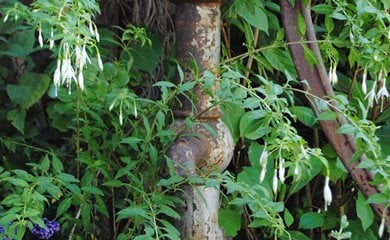
The antique water pump is the perfect addition to this shady bed, especially when surrounded by the raindrop-shaped white flowers of the ‘Hawkshead’ fuchsia. Photo by: Rebecca Sweet.
"Even in the shade, it’s hard to enjoy your garden when the temperatures outside are soaring. One way to counter-balance the oppressive heat is to create an illusion of coolness and tranquility. Using cool-toned colors on the color wheel (greens, blues, and purples) combined with other elements typically associated with water (watering cans, antique sprinklers, or water pumps) all come together to create the illusion of a lush and cool garden." —Rebecca Sweet, landscape designer, Harmony in the Garden
Incorporate some of these design ideas into your shady landscape:
- Create layers. Use a mix of trees, shrubs, perennials, bulbs, and annuals to create a layered tapestry that mimics a natural woodland.
- Use foliage. Rely on plants with interesting foliage such as hostas, Japanese forest grass, spotted lungwort (Pulmonaria), and coleus for long-lasting color throughout the growing season. Evergreens such as rhododendrons and conifers offer year-round color.
- Mix it up. Rely on color and texture, as well as varieties with different shapes and sizes to create visual interest.
- Brighten it up. Use foliage plants with chartreuse, gold, silver, or variegated leaves, or flowering plants with white or yellow blooms to make a dark space look brighter. Colorful containers, statuary, water features, reflective mirrors or panels, artwork, or other decorative accents are also effective for lightening a space.
- Add color. Use color to create a mood. Different tones of subtle green will make a space feel more serene. Colorful foliage or flowering plants such as impatiens and begonias will create more visual excitement.
- Keep it simple. Use larger drifts of the same plants for greater visual impact and to keep the design from becoming too busy.
- Go vertical. Use shade-tolerant vines such as clematis, climbing hydrangea, or Virginia creeper to add vertical interest, and soften walls and fences.
- Create repetition. Repeat the same or similar-looking plants in different parts of the yard. Use the same colors for plants and hardscape to unify the landscape.
- Lend cohesion. Use plants that thrive in partial sun to light shade for transition areas between shady and sunny areas.
- Hardscape. Use hardscape elements such as a pathway, patio, boulders, seating area, or structures such as an arbor or pergola to augment plantings.
- Eliminate the lawn. Traditional turf grass struggles to thrive in shady areas. Replace with hardscaping such as a patio, or mass a shade-tolerant ground cover.
- Install lighting. Add pathway, spot, or up-lighting to enjoy your space at night or during the darker days of winter.
SHADE GARDEN INSPIRATION

Plants in different colors, shapes, textures and sizes create a compelling tapestry. Designer: Gail Barnard. Photo: Janet Loughrey.
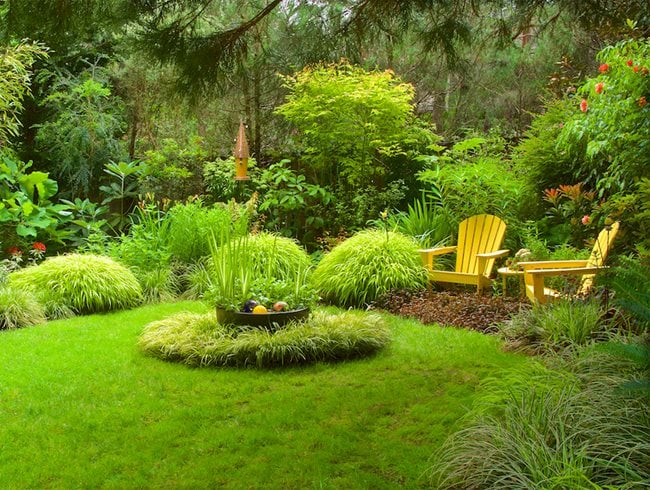
Chartreuse Japanese forest grass and golden Adirondack chairs brighten a deeply shaded area. Designer: Gail Barnard. Photo: Janet Loughrey.

Larger drifts of the same plants keep this shade border from becoming too busy. Designer: Mary DeNoyer. Photo: Janet Loughrey.

Different tones of subtle green create a serene border. Designer: Deborah Meyers. Photo: Janet Loughrey.

A layered tapestry of trees, shrubs, perennials, annuals and vines comprise this shady woodland garden. Designer: Vina Winters. Photo: Janet Loughrey.

Variegated climbing hydrangea creates vertical interest, while mophead hydrangeas and containers provide color in this shaded setting. Designer: Vina Winters. Photo: Janet Loughrey.
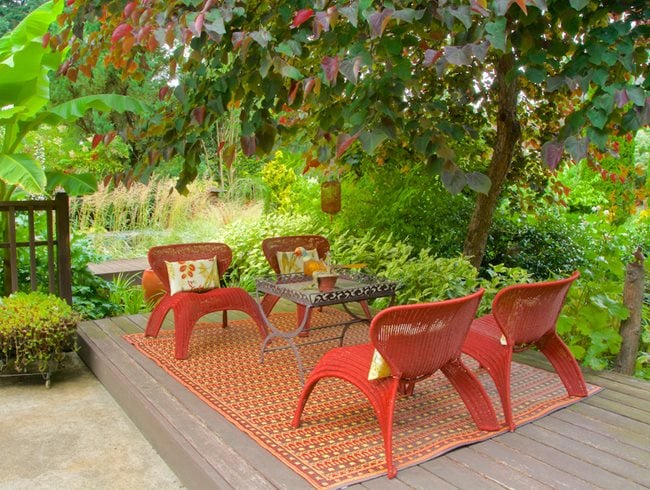
A shady spot under a redbud tree was transformed into a casual seating area. Designer: Vanessa Gardner Nagel. Photo: Janet Loughrey.

A rustic mirror reflects light into this shady space. Designer: Philip Thornburg, Winterbloom. Photo: Janet Loughrey.

This tiny urban backyard, situated in deep shade, became an inviting entertaining area for guests. Hardscape is softened by an eclectic mix of shade-tolerant plants. Designer: Kurt Beadell. Photo: Janet Loughrey.
See more shade garden pictures.
MORE SHADE GARDENS
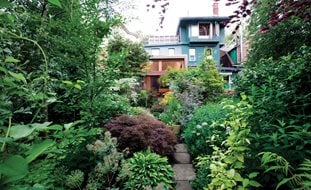
Discover how the owner of this property uses a layered, well-edited selection of plants for her specific shade conditions to create a dramatic garden with thrilling colors and textures.
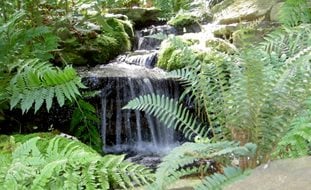
Ferns, mosses, hostas, and coleuses unite in this woodland landscape that makes the most of a hilly lot with a plethora of trees that keep the garden partially shaded at all times.
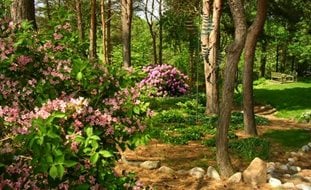
The owners of this Michigan garden cleared shady spots overrun with poison ivy to make room for lush fern and hosta gardens.
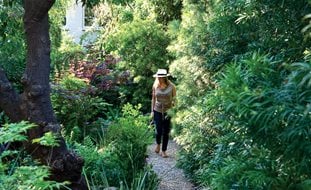
Shrouded by mature trees, this Los Angeles property is cool and shadowy, allowing shade ferns and philodendrons to coexist with jasmines, Japanese maples, succulents, and plumeria.

This public garden was originally carved out of native woodland on a rocky slope overlooking Puget Sound and is shaded by a canopy of towering, evergreen conifers.

Faced with a problematic slope and mature oaks that block much of the natural light, this Portland gardener created a winter jewel box featuring hellebores, winter hazel and snowdrops.
Reader Questions
My lawn languishes under several large shade trees. Is there anything I can do short of cranking up the chain saw?
See answer
The shady, narrow walkway beside our city house is a straight 30-foot shot, flanked by beds only a foot wide. Are there any ways to make this dead space come alive?
See answer
Get more gardening advice.
